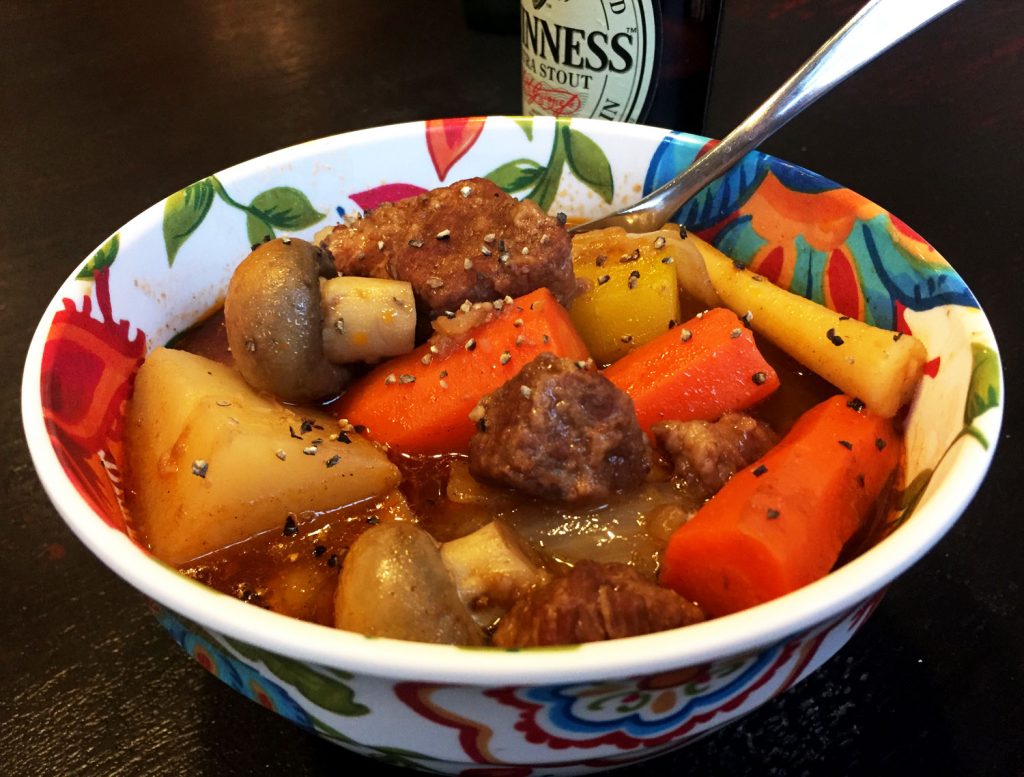
We may have Americanized Irish Stew with beef instead of lamb, but I don’t think St. Patrick would mind.
Things are greening up around town as we get ready for St. Patrick’s Day. Here in the United States, it’s serious business and failure to wear green on the blessed day may result in a pinch or two.
St. Patrick’s Day originated in Ireland as a religious holiday (pubs were closed on St. Patrick’s Day clear up until 1970) therefore the holiday is somewhat more subdued. St. Patrick was traditionally celebrated in Ireland for the missionary work he performed; he brought Christianity to the isle. As a result, the holiday is more of a religious event, similar to Easter and Christmas.
Irish immigrants fled to the United States during the Great Potato Famine in the mid-1800’s. They had a hard time finding work and were often despised for their religious beliefs. St. Patrick’s Day celebrations were often met with contempt. But as the number of Irish increased, celebrations became more and more common. What started as a few parades to cheer up homesick immigrants has turned into quite the celebration, whether or not you’re of Irish descent.
According to Census date, the number of Americans who claim Irish descent is around 40 million; that is more than seven times larger than the population of Ireland (www.irishcentral.com). As a result, we’ve re-invented St. Patrick’s Day as our own.
We pinch and/or kiss one another. We make green foods, drink green beer, dye our rivers and streams green and adapt Irish food to our own unique taste. As any good Irishman will tell you, lamb is the preferred meat for stew, but here in the U.S. we eat more beef than lamb, so when we choose to make Irish Stew, it’s usually beef instead of lamb, although we are willing to add a drop or two of Guinness to add some malty authenticity.
Irish Stew
Yield: 4-6 people
1 ¼ pounds of chuck stew meat, cut into 1 ½ inch cubes
Salt and Pepper
¼ cup all purpose flour
3 Tablespoons of olive oil
4 large garlic cloves, minced
4 cups of beef stock
1 cup of Guinness extra stout
1 cup of red wine
2 Tablespoons of tomato paste
1 Tablespoon of sugar
1 Tablespoon dried thyme
1 Tablespoon of Worcestershire sauce
2 bay leaves
2 Tablespoons of olive oil
1 large onion, chopped
2 cups of peeled and chopped (1/2 inch dice) carrots and/or parsnips
1 cup of chopped celery
½ pound of mushrooms,
3 pounds of Russet potatoes, peeled and cut into large chunks (about 7 cups)
Season the meat with the salt and pepper; set aside to come to room temperature (about 30 minutes). Transfer the meat to a zip top bag; add the flour, seal the bag and toss to coat.
Add the olive oil to a large Dutch oven and heat over medium high heat. Working in batches, add the beef to the pan. Take care not to crowd the pan or the meat will steam and not brown. Cook the meat, turning with tongs until the meat is well browned on all sides. Remove the beef to a plate to rest while you cook the rest of the meat.
Add the garlic to the pan and cook until just fragrant, about 30 seconds. Return the beef, along with any juices that have collected, to the Dutch oven. Add the stock, Guinness, red wine, tomato paste, sugar, thyme, Worcestershire sauce and bay leaves. Stir to combine.
Bring the stew to a simmer; reduce the heat to the lowest setting and then cover. Cook, barely simmering for 1 hour, stirring occasionally.
In a skillet, heat the oil over medium high heat; add the onions, carrots and celery. Sauté the vegetables until the onions are golden, 10 to 15 minutes.
When the meat has simmered for one hour, add the sautéed vegetables to the pot; add the mushrooms and potatoes. Stir to combine. Taste and adjust the seasoning. Simmer, uncovered until the vegetables and beef are very tender, about 40 minutes. Discard the bay leaves and spoon off any extra fat.
Irish Soda Bread
Yield: 1 loaf
4 cups of all-purpose flour
1 to 2 tablespoons of sugar
1 level teaspoon of salt
1 teaspoon of baking soda
1 cup raisins, currants or golden raisins
1 ¼ to 1½ cups of buttermilk
1 egg, lightly beaten
Preheat the oven to 450°F. Line a baking sheet with parchment paper; set aside.
Sieve the dry ingredients into a large mixing bowl; add the fruit and mix well. Make a well in the center and pour most of the milk in at once, with the egg. Using one hand, mix in the flour from the sides of the bowl, adding more milk if necessary. The dough should be softish, not too wet or sticky. When it all comes together, turn the dough out onto a floured board and knead it lightly for a few seconds, just enough to tidy it up. Pat the dough into a round about 1 ½ inches deep and cut a deep cross into the top to let out the fairies.
Bake for 15 minutes, then turn down the oven to 400°F and continue to cook for about 30 minutes or until golden brown. If you are in doubt, tap the bottom of the loaf. If it is cooked, it will sound hollow.











